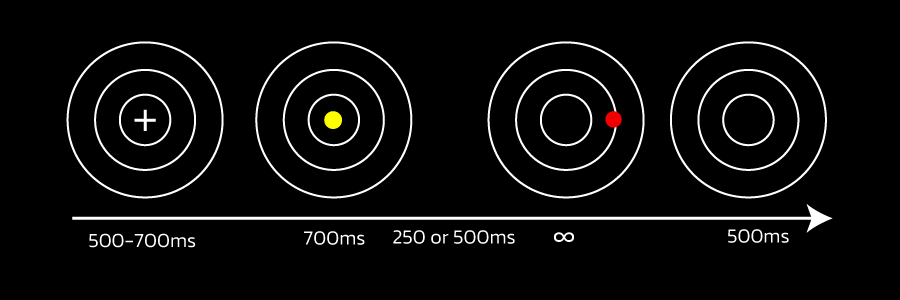案例研究:使用眼动追踪了解电子竞技运动员的瞄准技巧

在快速发展的电子竞技行业中,眼动追踪研究正在揭示精英表现背后的复杂机制,特别是在第一人称射击(FPS)等快节奏游戏中。在最近发表在《人类行为中的计算机》上的一项研究中,“经验丰富的第一人称射击游戏玩家的瞄准优势:来自眼动模式的证据,”杨等人(2025)通过分析经验丰富的FPS玩家在不同时空条件下的眼动模式,研究了他们的瞄准优势。该研究旨在全面了解支撑卓越瞄准能力的认知和感知过程。
Esport眼动追踪方法
这项研究涉及63名参与者:28名有经验的FPS玩家(至少有两年的常规FPS游戏和每周游戏时间)和35名非FPS玩家。
一个Eyelink 1000 Plus使用采样率为1000 Hz的眼动仪(SR Research Ltd,Canada)来跟踪和记录眼球运动数据。参与者坐在距离24英寸显示器57厘米的位置(1024×768分辨率,60 Hz刷新率),头部运动受到下巴托的限制。在开始和每次休息后进行9点校准,以确保数据准确性。
这项实验任务改编自《反恐精英2》,反映了动态瞄准,要求参与者在瞄准250毫秒或500毫秒后以不同角度和距离出现的红点之前点击中心黄点。参与者在72次试验中快速准确地击中目标。数据分析涵盖了行为测量(准确性、执行时间)和眼球运动指数(注视/扫视计数、持续时间、潜伏期、振幅),包括关键的非线性模式。

对于经验丰富的FPS玩家来说,视觉和运动反应之间的协调更有效
- 注视和扫视次数:与非FPS玩家相比,有经验的FPS玩家表现出的注视和扫视明显更少,表明视觉搜索更有效。目标距离也显著影响注视和扫视计数。
- 注视持续时间:观察到平均注视持续时间存在显著的三向相互作用(组x靶距离x靶出现潜伏期)。在500毫秒的条件下,经验丰富的FPS玩家对近目标的注视时间更长,与非FPS玩家相似,这表明任务难度的增加扰乱了他们的自动反应。
- 扫视潜伏期:目标出现潜伏期显著影响扫视潜伏期,在500ms条件下扫视启动速度更快。然而,这种更快的启动并没有转化为准确性或执行时间方面的性能提高。
眼动模式的非线性分析提供了超越传统分析的重要见解。
- 对于经验丰富的FPS玩家来说,最常见的眼球运动模式是“0-注视-1-扫视”模式,他们从目标出现到击中目标,只需一次扫视即可完成搜索瞄准过程,无需任何中间注视。这突显了它们卓越的空间重映射能力和高效的眼手协调能力。
- 相比之下,非FPS玩家通常表现出需要多次纠正调整的模式,例如“1-注视-2-扫视”模式(扫视目标,注视超过目标,然后扫视回目标)或“2-注视-3-扫视”模式。
这种模式层面的分析表明,在经验丰富的FPS玩家中,视觉输入和运动反应之间的协调更有效、更精细。
该研究强调了眼动追踪技术在揭示可能被传统统计方法掩盖的细微行为和认知特征方面的关键作用。通过分析非线性眼球运动模式,研究人员对专家表现的潜在机制有了更深入的了解,超越了简单的注视指标,如扫视潜伏期和注视持续时间。这篇论文表明,眼动追踪不仅是一种测量某人看向哪里的工具,也是了解个人在现实世界中如何处理视觉信息和执行复杂任务的强大工具。
有关眼动追踪如何帮助您的研究的信息,请查看我们的解决方案和产品页面或联系我们。我们很乐意为您提供帮助!
